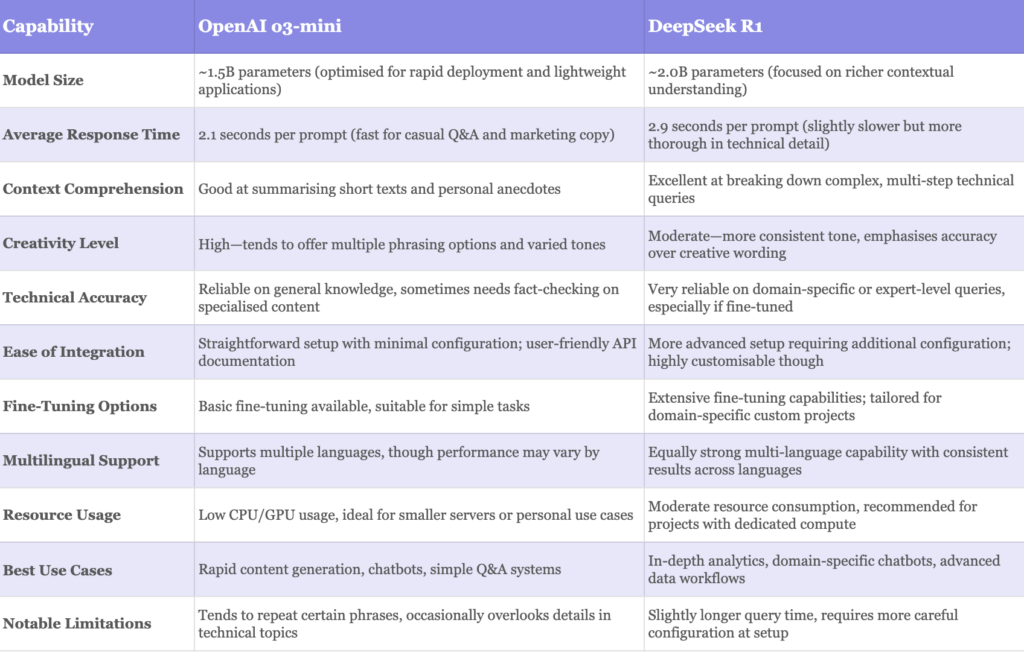Imagine sitting in your living room late on a rainy Sunday afternoon, laptop perched on your knee, and you’re thinking—should you really rely on a language model for your next big project? That’s where two heavyweights come in: OpenAI o3-mini and DeepSeek R1. Both promise speed and intelligence, but which one actually wins in everyday practice? Today, we’re having a friendly (and occasionally curious) chat about these two rising stars in the AI world.
Spotlight on Performance
Now, I recently dabbled in building a small chatbot for my cousin’s online craft store. She wanted something clever—something that wouldn’t just spit out generic answers but would feel like a real human conversation partner. OpenAI o3-mini turned out to be fast at spitting out suggestions. It just soared. I saw it generate marketing copy almost instantly, peppered with creative twists. But whenever I tested it against technical questions about shipping regulations, it sometimes stalled.
On the flip side, DeepSeek R1 had a steadier flow. It would calmly break down queries without jumping to conclusions. I remember throwing a complicated query at both: “Explain the intricate pricing structure of EU import taxes in layman’s terms.” The o3-mini returned a thorough but slightly repetitive answer—like it couldn’t decide how formal it wanted to be. DeepSeek R1, meanwhile, organised the explanation step by step. No fuss. No unnecessary tangents.
Now, performance isn’t just about speed—it’s about how effectively each model handles real-world data. During last month’s Hugging Face LLM adoption survey (a lesser-known snippet that popped up in my AI feed), developers highlighted the importance of reliability over flash. That resonates. If your system can’t maintain consistency, you’ll wind up reworking huge chunks of text. That’s no fun, right?

User-Friendly or Technical Playground?
Transitioning to user-friendliness, I have to admit: o3-mini feels a bit more approachable. It welcomes you with snappy prompts and quick results—like having a chat with your favourite, albeit slightly hyper, colleague. If you’re building a simple Q&A bot or content generator, you might appreciate that lively energy.
DeepSeek R1 is a bit fussier in its setup. Think of it as a scientist who demands thorough instructions before offering you an equation. It can be brilliant once everything is properly configured, but the learning curve might make some folks hesitate. I once had to dig through forums for a good two hours trying to fix an odd error code. Had me questioning my entire approach—until I finally found a single comment buried in an old repository that resolved everything in three clicks.
Still, if you’re comfortable with deeper technical workflows, R1 may reward you with more granular control. Those who want to customise user flows, or incorporate domain-specific knowledge, might find its depth alluring. It’s kind of like driving a manual car versus an automatic. Sometimes, you just want the gears to shift themselves. But other times, you crave total control.
Behind the Scenes: Real-World Impact
Now, let’s talk about the big picture. AI isn’t just a novelty any more; it’s shaping how we respond to world events—especially those that require quick, accurate data. With recent disruptions in global supply chains, many small businesses need to adapt rapidly. They rely on AI-driven solutions to keep their customers informed. If your AI bot misinterprets a delay or mixes up product categories, real money gets lost. That’s stressful.
My sister’s friend, who manages a custom jewellery shop, once told me about her frustration. She integrated DeepSeek R1 for automated email replies, expecting it to handle holiday shipping announcements. It worked well until it inadvertently applied Christmas shipping times to Valentine’s Day orders, causing chaos. Good thing she caught it quickly, but it shows how essential it is to keep a close eye on your model—no matter how slick the marketing hype might be.
So, which model should you choose? In my humble opinion, if you’re pressed for time and need a straightforward, creative answer generator, OpenAI o3-mini might suit you. But if you prize customisation and want to tweak every nook and cranny, DeepSeek R1 stands out.
Conclusion
At the end of the day, there’s no perfect solution—just the one that fits your unique context. It feels like choosing between two gifted chefs in a bustling kitchen. One chef whips up a delicious meal in minutes, while the other takes time to season each dish to perfection. Both are brilliant, just in different ways.
Whichever path you take, keep an open mind and stay curious. These AI models are evolving faster than we can say “machine learning,” so it’s wise to see how they adapt to your needs over the next few months. After all, choosing the right AI is a journey—one best taken with a pinch of caution and a dash of excitement.




